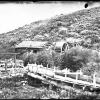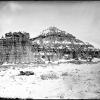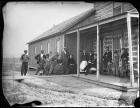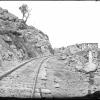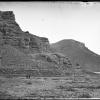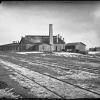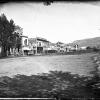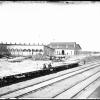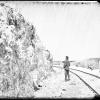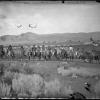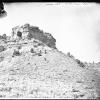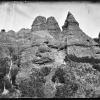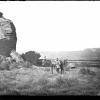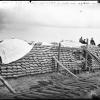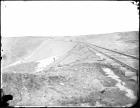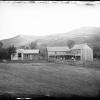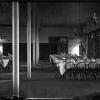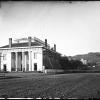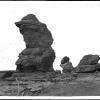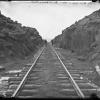Andrew J. Russell
One of a handful of landscape photographers who shaped our perception of the American West in the 19th century, A. J. Russell’s work stands alongside of Carleton Watkins, Eadweard Muybridge and Timothy O’Sullivan in its aesthetic power and technical virtuosity. A large group of Russell’s original glass-plate negatives are preserved in the Collection of the Oakland Museum of California.
A painter as well as photographer, Russell worked for Matthew Brady before documenting the U.S. Military Railroad as a captain during the Civil War. After the war, he secured a position as official photographer for the Union Pacific Railroad in its massive endeavor to construct a transcontinental railroad. His photographs, culminating in the iconic “Joining of the Rails” at Promontory, Utah, capture the majestic scale of western lands, the gritty enterprise of railroad building, frontier boom towns, and the effect of railroads on Native Americans.
Russell’s photographs brought the railroad, and the American West, to a mass audience. Disseminated internationally as stereo views and engravings in newspapers, and filtered through Hollywood films and even advertising, Russell’s visual style continues to influence our image of western history and mythology.
In 1969 the Oakland Museum acquired nearly 650 collodion “wet plate” negatives in both stereo and “imperial” (10 X 13 inch) formats. The original glass camera negatives were made in the field by Russell himself, making the collection unique, among major 19th century landscape photographers. The Museum also holds one of the few surviving copies of The Great West Illustrated, an album of vintage albumen prints by Russell, as well as mounted stereo views and more than 100 glass lantern slides.
Russell’s photographs illuminate powerful themes in American history: westward expansion and Manifest Destiny, the displacement of native peoples, attitudes toward landscape and the natural environment, technological history (both engineering and photographic), and the important role of art and photography in shaping and expressing cultural concerns.
For the first time, high-resolution digital scans of the original glass-plate negatives are now available for online viewing. These scans are highly detailed and rich in searchable content.
This project is supported in part by an award from the National Endowment for the Arts.

View results as Grid View results as List Browse Full Collection Advanced Search
